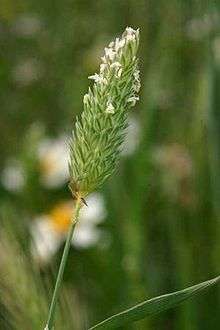Phalaris minor
| Phalaris minor | |
|---|---|
 | |
| Scientific classification | |
| Kingdom: | Plantae |
| (unranked): | Angiosperms |
| (unranked): | Monocots |
| (unranked): | Commelinids |
| Order: | Poales |
| Family: | Poaceae |
| Genus: | Phalaris |
| Species: | P. minor |
| Binomial name | |
| Phalaris minor Retz. | |
Phalaris minor is a species of grass native to North Africa, Europe, and South Asia.[1] The bunchgrass is widely naturalised elsewhere.
Common names include little seed canary grass, small-seeded canary grass, small canary grass,[2] lesser-canary grass,[3] guli danda (Hindi), and sittee booti (Urdu).[4]
Description
Phalaris minor grows as a tufted annual bunchgrass up to 1.8 metres (5.9 ft) in height. It has a spike-like panicle.[5]
Taxonomy
It has had an uneventful taxonomic history. It was first published under its current name by Anders Jahan Retzius in 1783, and has retained that name since. It has no synonyms, and no infraspecific taxa.[6]
Uses
It is used as a fodder or forage for livestock and birdseed, but is poisonous to some mammals, and is a potential contaminant of seed crops.[1]
References
- 1 2 "Phalaris minor Retz.". Germplasm Resources Information Network (GRIN).
- ↑ "Sorting Phalaris names". Multilingual Multiscript Plant Name Database. Retrieved 2009-01-08.
- ↑ "BSBI List 2007". Botanical Society of Britain and Ireland. Archived from the original (xls) on 2015-02-25. Retrieved 2014-10-17.
- ↑ Phalaris minor. IDAO.
- ↑ Retz. "New South Wales Flora Online: Phalaris minor". Royal Botanic Gardens & Domain Trust, Sydney, Australia.
- ↑ "Phalaris minor Retz.". Australian Plant Name Index (APNI), IBIS database. Centre for Plant Biodiversity Research, Australian Government.